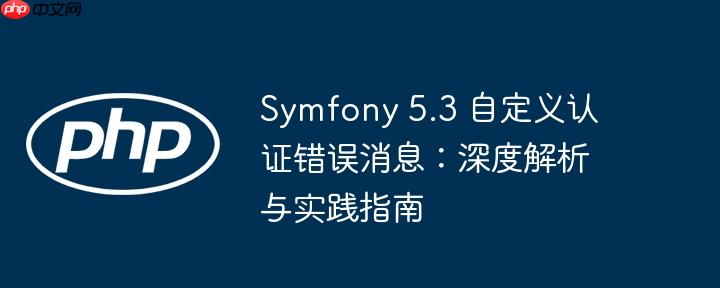
在 symfony 5.3 的新认证系统中,当用户登录失败时,框架会通过一系列内部流程来捕获和处理认证异常。核心在于 authenticationexception 的抛出与捕获,以及其最终如何传递到前端视图。
onAuthenticationFailure() 方法的作用:AbstractLoginFormAuthenticator 中的 onAuthenticationFailure() 方法并非用于 抛出 自定义异常,而是用于 处理 已经抛出的 AuthenticationException。当认证过程中的任何环节(例如,凭据验证失败、用户不存在或账户状态异常)抛出 AuthenticationException 时,Symfony 的 AuthenticatorManager 会捕获它,并调用当前活跃认证器的 onAuthenticationFailure() 方法。此方法通常会将异常存储到会话中,以便后续通过 AuthenticationUtils 获取。
原始代码中尝试在 onAuthenticationFailure() 中 throw new CustomUserMessageAuthenticationException('error custom '); 是无效的,因为此时已经处于异常处理流程中,再次抛出异常会中断当前流程,并且不会被 AuthenticationUtils 捕获为预期的登录错误。
AuthenticationUtils 如何获取错误:AuthenticationUtils::getLastAuthenticationError() 方法的核心逻辑是从当前请求的会话中获取由 Security::AUTHENTICATION_ERROR 键存储的 AuthenticationException 对象。默认情况下,AbstractLoginFormAuthenticator::onAuthenticationFailure() 会执行 $request->getSession()->set(Security::AUTHENTICATION_ERROR, $exception); 来存储这个异常。因此,如果你想在 Twig 视图中显示自定义错误,你需要确保正确的 AuthenticationException 子类(包含自定义消息)被存储到会话中。
要成功显示自定义错误消息,你需要在认证流程中 导致认证失败 的地方抛出 CustomUserMessageAuthenticationException 或 CustomUserMessageAccountStatusException。这些异常的构造函数接受一个字符串参数,该参数将作为错误消息显示给用户。
在定制错误消息之前,一个非常重要的配置项是 security.yaml 中的 hide_user_not_found。 默认情况下,Symfony 会隐藏用户不存在(UsernameNotFoundException)或某些账户状态异常(非 CustomUserMessageAccountStatusException 类型)的详细信息,将其替换为通用的 BadCredentialsException('Bad credentials.')。
如果你希望 CustomUserMessageAuthenticationException 或 CustomUserMessageAccountStatusException 的原始消息能够传递到视图,你需要将 hide_user_not_found 设置为 false:
# config/packages/security.yaml
security:
# ...
hide_user_not_found: false # 允许显示更具体的错误消息
firewalls:
# ...注意事项: 将 hide_user_not_found 设置为 false 可能会泄露一些敏感信息,例如用户名是否存在。在生产环境中,请权衡安全性和用户体验。如果保持 hide_user_not_found: true,则应使用 CustomUserMessageAccountStatusException 来绕过此限制,因为它不会被替换为 BadCredentialsException。
以下是在 Symfony 认证流程中可以抛出自定义异常的常见位置:
在认证器 (Authenticator) 类中: 这是最常见且推荐的位置,尤其是当认证失败的原因与凭据验证逻辑直接相关时。你应该扩展 AbstractLoginFormAuthenticator 而不是直接修改它。
// src/Security/LoginFormAuthenticator.php
namespace App\Security;
use Symfony\Component\HttpFoundation\Request;
use Symfony\Component\Security\Core\Exception\CustomUserMessageAuthenticationException;
use Symfony\Component\Security\Http\Authenticator\AbstractLoginFormAuthenticator;
use Symfony\Component\Security\Http\Authenticator\Passport\Badge\UserBadge;
use Symfony\Component\Security\Http\Authenticator\Passport\Passport;
use Symfony\Component\Security\Http\Authenticator\Passport\Credentials\PasswordCredentials;
use Symfony\Component\Security\Http\Util\TargetPathTrait;
use Symfony\Component\Routing\Generator\UrlGeneratorInterface;
class LoginFormAuthenticator extends AbstractLoginFormAuthenticator
{
use TargetPathTrait;
public const LOGIN_ROUTE = 'app_login';
private UrlGeneratorInterface $urlGenerator;
public function __construct(UrlGeneratorInterface $urlGenerator)
{
$this->urlGenerator = $urlGenerator;
}
public function authenticate(Request $request): Passport
{
$email = $request->request->get('email', '');
// 示例:如果邮箱格式不正确,可以抛出自定义异常
if (!filter_var($email, FILTER_VALIDATE_EMAIL)) {
throw new CustomUserMessageAuthenticationException('邮箱格式不正确,请重新输入。');
}
// ... 其他认证逻辑
$request->getSession()->set('_security.last_username', $email);
return new Passport(
new UserBadge($email),
new PasswordCredentials($request->request->get('password', '')),
[
// ... 其他徽章
]
);
}
protected function getLoginUrl(Request $request): string
{
return $this->urlGenerator->generate(self::LOGIN_ROUTE);
}
// ... 其他方法,如 onAuthenticationSuccess
}在 authenticate() 方法中,你可以根据业务逻辑(例如,用户输入的凭据是否符合要求、是否在数据库中找到用户等)抛出 CustomUserMessageAuthenticationException。
在用户提供者 (User Provider) 类中: 当用户身份验证失败的原因是用户不存在或无法加载时,可以在用户提供者中抛出异常。
// src/Repository/UserRepository.php
namespace App\Repository;
use App\Entity\User;
use Doctrine\Bundle\DoctrineBundle\Repository\ServiceEntityRepository;
use Doctrine\Persistence\ManagerRegistry;
use Symfony\Bridge\Doctrine\Security\User\UserLoaderInterface;
use Symfony\Component\Security\Core\Exception\CustomUserMessageAuthenticationException;
use Symfony\Component\Security\Core\User\UserInterface;
class UserRepository extends ServiceEntityRepository implements UserLoaderInterface
{
public function __construct(ManagerRegistry $registry)
{
parent::__construct($registry, User::class);
}
public function loadUserByIdentifier(string $identifier): UserInterface
{
// 示例:如果找不到用户,抛出自定义消息
$user = $this->createQueryBuilder('u')
->where('u.email = :identifier')
->setParameter('identifier', $identifier)
->getQuery()
->getOneOrNullResult();
if (!$user) {
// 如果 hide_user_not_found 为 true,此消息仍会被 BadCredentialsException 覆盖
// 除非你使用 CustomUserMessageAccountStatusException 且 hide_user_not_found 为 true
throw new CustomUserMessageAuthenticationException('该邮箱尚未注册。');
}
return $user;
}
}这里需要注意 hide_user_not_found 的影响。如果它为 true,即使你抛出 CustomUserMessageAuthenticationException,它也可能被 BadCredentialsException 覆盖。若要绕过此限制,可以考虑在适当场景下抛出 CustomUserMessageAccountStatusException。
在用户检查器 (User Checker) 类中: 用户检查器用于在认证前后检查用户账户状态(例如,账户是否被禁用、是否已过期、是否需要邮箱验证等)。
// src/Security/UserChecker.php
namespace App\Security;
use App\Entity\User; // 假设你的用户实体是 App\Entity\User
use Symfony\Component\Security\Core\User\UserInterface;
use Symfony\Component\Security\Core\User\UserCheckerInterface;
use Symfony\Component\Security\Core\Exception\CustomUserMessageAccountStatusException;
use Symfony\Component\Security\Core\Exception\DisabledException; // 示例:如果用户被禁用
class UserChecker implements UserCheckerInterface
{
public function checkPreAuth(UserInterface $user): void
{
if (!$user instanceof User) {
return;
}
// 示例:在认证前检查用户是否被禁用
if (!$user->isActive()) { // 假设 User 实体有一个 isActive() 方法
// 使用 CustomUserMessageAccountStatusException 可以在 hide_user_not_found 为 true 时仍显示自定义消息
throw new CustomUserMessageAccountStatusException('您的账户已被禁用,请联系管理员。');
}
}
public function checkPostAuth(UserInterface $user): void
{
if (!$user instanceof User) {
return;
}
// 示例:在认证后检查用户是否已验证邮箱
if (!$user->isEmailVerified()) { // 假设 User 实体有一个 isEmailVerified() 方法
throw new CustomUserMessageAccountStatusException('请先验证您的邮箱以激活账户。');
}
}
}UserChecker 是处理账户状态相关错误的理想位置。使用 CustomUserMessageAccountStatusException 的一个主要优势是,即使 hide_user_not_found 设置为 true,它也不会被替换为通用的 BadCredentialsException,从而允许你显示更具体的账户状态错误消息。
一旦上述任一位置抛出了带有自定义消息的 CustomUserMessageAuthenticationException 或 CustomUserMessageAccountStatusException,并且 hide_user_not_found 配置得当,AuthenticationUtils::getLastAuthenticationError() 就能正确获取到该异常。你的 Twig 视图(如 security/login.html.twig)中现有的错误显示逻辑将能够直接利用这些自定义消息。
{# security/login.html.twig #}
{% block body %}
<form method="post">
{% if error %}
{# error.messageKey 将是 CustomUserMessageAuthenticationException 构造函数中的消息 #}
<div class="alert alert-danger">{{ error.messageKey|trans(error.messageData, 'security') }}</div>
{% endif %}
{# ... 其他登录表单字段 #}
</form>
{% endblock %}error.messageKey 会包含你通过 CustomUserMessageAuthenticationException 或 CustomUserMessageAccountStatusException 传递的自定义字符串。|trans 过滤器允许你进一步对这些消息进行国际化处理。
通过遵循这些指南,你可以在 Symfony 5.3 中灵活、专业地定制认证错误消息,从而提升应用程序的用户体验。
以上就是Symfony 5.3 自定义认证错误消息:深度解析与实践指南的详细内容,更多请关注php中文网其它相关文章!

每个人都需要一台速度更快、更稳定的 PC。随着时间的推移,垃圾文件、旧注册表数据和不必要的后台进程会占用资源并降低性能。幸运的是,许多工具可以让 Windows 保持平稳运行。

Copyright 2014-2025 https://www.php.cn/ All Rights Reserved | php.cn | 湘ICP备2023035733号